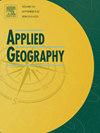Towards a socially resilient city: Healthcare accessibility and rural migrants’ identity integration in urban China
IF 4
2区 地球科学
Q1 GEOGRAPHY
引用次数: 0
Abstract
Aligned with the Sustainable Development Goals' emphasis on mitigating inequalities and fostering inclusive human settlements, China initiated the New-Type Urbanization (NTU) plan to reduce disparities in public service access for rural migrants, with healthcare accessibility being a primary focus. This study pioneers the exploration of the relationship between the temporal distance to healthcare services and rural migrants' identity integration through the lens of social resilience. Theoretically, we posit that economic, perceived, and institutional supports shape this relationship, highlighting the mediating role of urban contexts. Empirically, our analysis utilizes survey data from 94,221 rural migrants across 172 prefecture-level cities, employing a multilevel logistic regression model. The findings indicate that neoclassical and structural perspectives provide limited explanatory power for the relationship between healthcare accessibility and rural migrants’ identity integration at the city level. Our analysis revealed that enhanced healthcare access significantly strengthens identity integration, particularly in cities with limited medical resources or challenging living conditions, such as severe air pollution and inadequate green spaces. These results underscore the critical role of perceived support and partially affirm the significance of institutional support. We propose optimizing spatial healthcare planning as a strategic solution to address medical staff shortages and enhance healthcare accessibility.
求助全文
约1分钟内获得全文
求助全文
来源期刊

Applied Geography
GEOGRAPHY-
CiteScore
8.00
自引率
2.00%
发文量
134
期刊介绍:
Applied Geography is a journal devoted to the publication of research which utilizes geographic approaches (human, physical, nature-society and GIScience) to resolve human problems that have a spatial dimension. These problems may be related to the assessment, management and allocation of the world physical and/or human resources. The underlying rationale of the journal is that only through a clear understanding of the relevant societal, physical, and coupled natural-humans systems can we resolve such problems. Papers are invited on any theme involving the application of geographical theory and methodology in the resolution of human problems.
 求助内容:
求助内容: 应助结果提醒方式:
应助结果提醒方式:


